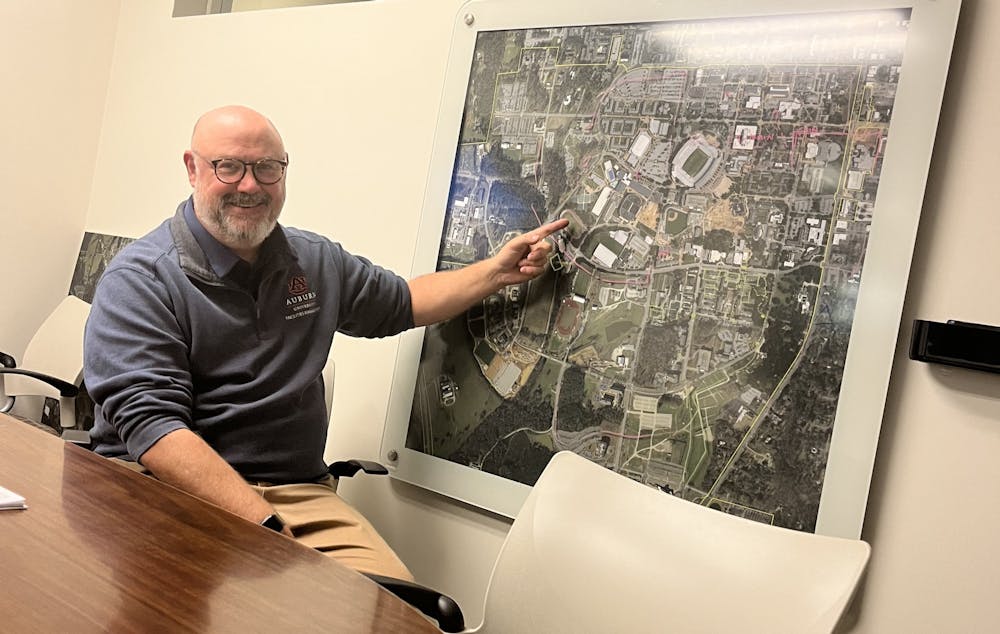The grab bar needs to be just in the right place. The toilet should be 15 inches high, not 17. The flushing switch needs to be on the opposite side of the wall.
Accessible housing is a must for a university to comply with the 2010 Americans with Disabilities Act code and to provide a safe, diverse environment for students of all abilities. It might seem simple: slap a handicap tag on the door and make sure there are no stairs, then everything is fine.
However, according to Auburn University Architect Simon Yendle, there is a lot more attention to detail and planning that goes into providing accessible living on campus.
“(Designing accessible units) is all about barrier removal and trying to provide the same living experience that other people are going to have,” Yendle said. “We want to standardize the experience for all students the best we can. Just because they may have a mobility issue, they shouldn’t have something extra special, but it should accommodate their needs.”
With this task comes a lot of research, pages of codes and a peer review system. The big issues when trying to remove barriers are accessible routes, heights, clearance and reach. The turning radius is also required to be a minimum of 42 inches.
With all the accommodations that are necessary to make independent living go smoothly, moving far from home can be daunting for a student with mobility impairments – especially new ones like freshman wheelchair basketball player and Wisconsin native Travis Beckler. But the university housing department along with the Office of Accessibility is helping minimize those worries.
“It was great coming in because it just eased some anxiety of living on my own,” Beckler said. “It’s made it easy because I can get around and do everything I need or want to do. I can worry about school or other things that I need and not worry about my dorm.”
According to Barclay Bentley, director of the Auburn University Office of Accessibility, Beckler and Breanna Thrasher, junior in equine science, taking the trash in the South Donahue dorm was difficult for those with a mobility device due to the height of the trash bin and the incline it sits on.
Students let the Office of Accessibility know, and Bentley contacted the housing department and worked out a trash pickup system for mobility-impaired students from then on.
“I have zero concern that students are going to be placed in a dorm that meets their needs, and if they don’t get placed in a dorm that meets their needs, housing will find out a way to make it right,” Bentley said. “(The housing department) is good to work with, and they’re friendly people and they’re very nice, and they know what this is about.”
To solve accessibility issues, housing has to comply with three codes: the 2010 ADA code, the Fair Housing Amendments and the American National Standard Institute 119. These codes deal with topics from counter heights and door width to grab bar placement and clearance space for people to use devices such as a walker or wheelchair to turn around or reach items.
But these codes often overlap and counter each other. For example, Yendle said the 2010 ADA code gives a range of 15 to 19 inches for toilet height, while ANSI 119 narrows that range from 17 to 19 inches.
This is where a peer reviewer comes into play. The designers will go to specialists who are professionals in whatever type of building they are designing. For example, they would contact a doctor for a hospital, a teacher for a classroom and for an accessible dorm or apartment, an accessibility specialist.
Once that is done, the building design gets reviewed by the division of construction management, which is under the state authority. The designs consist of exact routes and unit locations that are color-coated by a bunch of marks that show clearances and barrier removals.
“We (architects) have some formal training relative to how to create space and how to design a building to meet the guidelines and codes,” Yendle said. “Because it is so complex, we also reach out to an expert who’s really up to date on those specific codes. Getting to the design is one thing, but making sure it’s built correctly is another.”
In addition to the inside of rooms, designers start with parking and an accessible route to rooms, whether it is an accessible unit or not. In order to clear barriers, they provide ramps, handicap spaces in the right locations, clear sidewalks and level ground.
Elevator placement and accessible entrances are considered, but automatic doors are not a requirement according to the 2010 ADA code – a concern for some mobility-impaired students.
“South Donahue dorms’ doors – you know, the front doors have (automatic door) buttons, but once you get to where the rooms are there’s no buttons, so if you are carrying stuff it’s hard to get past the door with a mobility aid,” Thrasher said.
Students noted things like a key card to open their doors, easy access to the mail room and the addition of trash pickup as things that have been particularly helpful in their time living at Auburn.
Though students recognize that Auburn housing’s accessibility is not perfect, they, along with Bentley, commend Auburn for its willingness to adapt and accommodate specific people’s needs.
“We had a guy that I was telling you about that got placed in the wrong spot, but he got billed for the higher rate,” Bentley said. “We worked it out with him to make sure that, because his original placement was wrong, he’ll get a discounted rate for this year, and then he’ll decide what he wants to do for next year. (The housing department is) very good about working with me on those things… they’re very responsive.”
Thrasher and Beckler said that University housing has fulfilled its mission of giving mobility-impaired students a similar experience to able-bodied students, but there are still necessary adaptations to make.
“I’m able to be a lot more independent because of the roll-in showers and trash pickup,” Thrasher said. “It makes things easier, but the main issue with South Donahue was the fire safety because I was not told what I’m supposed to do or when I’m supposed to do it. There needs to be more education on that for disabled people and R.A.s. I would also ask that they provide adjustable beds in ADA rooms.”
Auburn University freshman and wheelchair basketball player Jay Denning and Beckler also mentioned the fire safety issue that forces them to find an alternate route outside of the elevator, but both said they were able to work it out by contacting the Office of Accessibility.
Yendle is aware that adaptations are necessary to accommodate different people’s needs, but the designers seem to lack one thing: input from people living in the units. Planning for how to best accommodate those with disabilities is nearly impossible without hearing what their housing experiences are.
“That’s how they can make the experience better for us is to actually talk to somebody that goes through it on a daily basis,” Thrasher said.
While adjustable kitchenettes and sink cabinets are designed in accessible rooms to be replaced to fit the individual’s needs, there are some needs that can’t be understood without experience – things like Thrasher getting stuck on the stairs during a fire drill or a disabled person attempting to hoist themselves on top of a bed that’s too tall to transfer to from a seated position.
For many disabled people, the path to accessible living is a crooked line with loops and roadblocks, but it is assuring that Auburn Housing is working to remove those blocks.
“I’m thankful for the opportunity to live on campus and get to my classes,” Thrasher said. “Overall, it isn’t perfect, but it’s helped improve things to what it would be if I didn’t have the opportunity to live on campus.”
Do you like this story? The Plainsman doesn't accept money from tuition or student fees, and we don't charge a subscription fee. But you can donate to support The Plainsman.
Noah is a senior in journalism from Salem, Alabama. He joined the Plainsman in August of 2021 after transferring in from Southern Union Community College.
Twitter: @NoahGG01





